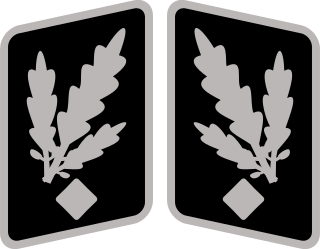
Gruppenführer was an early paramilitary rank of the Nazi Party (NSDAP), first created in 1925 as a senior rank of the SA. Since then, the term Gruppenführer is also used for leaders of groups/teams of the police, fire departments, military and several other organizations.

Obergruppenführer was one of the Third Reich's paramilitary ranks that was first created in 1932 as a rank of the Sturmabteilung (SA) and adopted by the Schutzstaffel (SS) one year later. Until April 1942, it was the highest commissioned SS rank after only Reichsführer-SS. Translated as "senior group leader", the rank of Obergruppenführer was senior to Gruppenführer. A similarly named rank of Untergruppenführer existed in the SA from 1929 to 1930 and as a title until 1933. In April 1942, the new rank of SS-Oberst-Gruppenführer was created which was above Obergruppenführer and below Reichsführer-SS.

The uniforms and insignia of the Schutzstaffel were used for the Nazi paramilitary ranks of the Schutzstaffel (SS) between 1925 and 1945 to differentiate that organization from the Wehrmacht as the regular German armed forces, the German state, and the Nazi Party.
This is a list of words, terms, concepts and slogans of Nazi Germany used in the historiography covering the Nazi regime. Some words were coined by Adolf Hitler and other Nazi Party members. Other words and concepts were borrowed and appropriated, and other terms were already in use during the Weimar Republic. Finally, some are taken from Germany's cultural tradition.

Mann, was a paramilitary rank used by several Nazi Party paramilitary organizations between 1925 and 1945. The rank is most often associated with the Schutzstaffel (SS-Mann), but also was a rank of the SA, where Mann (SA-Mann) was the lowest enlisted rank and was the equivalent of a private.
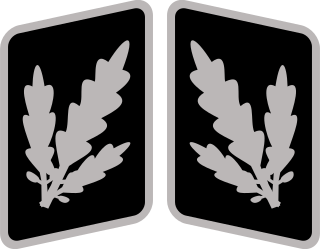
Brigadeführer was a paramilitary rank of the Nazi Party (NSDAP) that was used between the years of 1932 to 1945. It was mainly known for its use as an SS rank. As an SA rank, it was used after briefly being known as Untergruppenführer in late 1929 and 1930.

Scharführer was a title or rank used in early 20th Century German military terminology. In German, Schar was one term for the smallest sub-unit, equivalent to a "troop", "squad", or "section". The word führer simply meant "leader".

Blockleiter, where block refers to city block, was from 1933 the title of a lower Nazi Party political rank responsible for the political supervision of a neighborhood. Referred to in common parlance as Blockwart, the Block Warden's duty was to form the primary link between the Nazi authorities and the general population. The derogatory term Blockwart ("snoop") survives in German colloquial language.
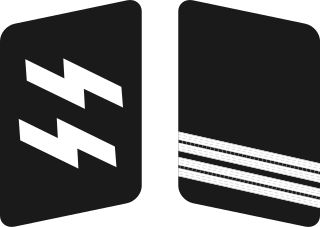
Rottenführer was a Nazi Party paramilitary rank that was first created in the year 1932. The rank of Rottenführer was used by several Nazi paramilitary groups, among them the Sturmabteilung (SA), the Schutzstaffel (SS) and was senior to the paramilitary rank of Sturmmann.
Haupttruppführer was a Nazi Party paramilitary rank that existed between the years of 1930 and 1945. Haupttruppführer was mainly used as a rank of the Sturmabteilung (SA), but was also used by the Schutzstaffel (SS) in the early days of that group's existence.

Oberscharführer was a Nazi Party paramilitary rank that existed between 1932 and 1945. Oberscharführer was first used as a rank of the Sturmabteilung (SA) and was created due to an expansion of the enlisted positions required by growing SA membership in the late 1920s and early 1930s. The SA rank of Oberscharführer was senior to Scharführer and junior to the rank of Truppführer.

Unterscharführer was a paramilitary rank of the Nazi Party used by the Schutzstaffel (SS) between 1934 and 1945. The SS rank was created after the Night of the Long Knives. That event caused an SS reorganisation and the creation of new ranks to separate the SS from the Sturmabteilung (SA).
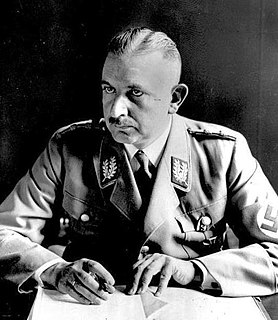
Ranks and insignia of the Nazi Party were paramilitary titles used by the National Socialist German Workers' Party (NSDAP) between approximately 1928 and the fall of Nazi Germany in 1945. Such ranks were held within the political leadership corps of the Nazi Party, charged with the overseeing of the regular Nazi Party members.

Gorget patches are an insignia in the form of paired patches of cloth or metal on the collar of a uniform (gorget), used in the military and civil service in some countries. Collar tabs sign the military rank, the rank of civil service, the military unit, the office (department) or the branch of the armed forces and the arm of service.

The Gau Munich–Upper Bavaria was an administrative division of Nazi Germany in Upper Bavaria from 1933 to 1945. From 1930 to 1933, it was the regional subdivision of the Nazi Party in that area.
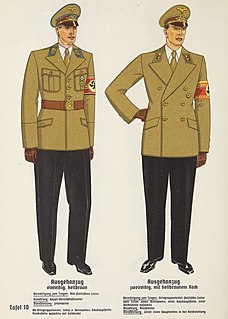
Zellenleiter was a Nazi Party political title which existed between the years of 1930 and 1945. A Zellenleiter was higher in rank than a Blockleiter and was in charge of a "Nazi Cell", composed of eight to twelve city blocks.
Arbeitsleiter, German for work leader, was also a Nazi Party political rank which existed between 1939 and 1945. The rank was created to replace the former rank of mitarbeiter and was divided into three levels of arbeitsleiter, oberarbeitsleiter, and hauptarbeitsleiter.

Gemeinschaftsleiter was a Nazi Party political rank which existed between 1939 and 1945. Created primary to replace the older rank of Stützpunktleiter, the rank of Gemeinschaftsleiter was often used on the local level of the Nazi Party to denote the second in command of a municipal region, answering to a regional Nazi known by the title of Ortsgruppenleiter.

Einsatzleiter was a mid-level Nazi Party political rank created in 1939 as a replacement for the older rank of Amtsleiter. Like its predecessor, the rank of Einsatzleiter was a generic staff position common across all levels of the Party, typically assigned to administrative or clerical duties.
Betriebsobmann was a political position of the Nazi Party which existed between the years 1939 and 1945. The term first came into being at the start of World War II and was unique only to the local level of the Nazi Party, known as the Ortsgruppen.


















